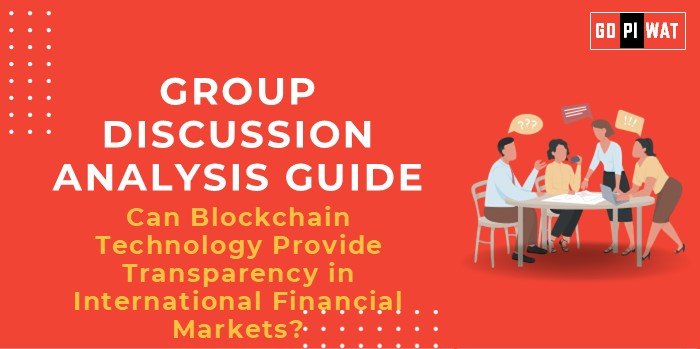📋 Group Discussion (GD) Analysis Guide
Can Blockchain Technology Provide Transparency in International Financial Markets?
🌐 Introduction to Blockchain in International Financial Markets
Opening Context: “Blockchain, initially popularized by cryptocurrencies like Bitcoin, has evolved into a transformative technology across various sectors, including international finance. Its potential to enhance transparency in financial markets is particularly significant amidst global calls for improved accountability.”
Topic Background: The technology underpins a distributed ledger system, reducing fraud and enhancing trust through immutable records. Recent examples like the European Union’s pilot blockchain project for securities trading emphasize its growing relevance.
📊 Quick Facts and Key Statistics
- Global Blockchain Market Size: $7.18 billion in 2022, projected to reach $163 billion by 2029 (Statista).
- Fraud in International Trade: Estimated at $4.5 trillion annually, indicating blockchain’s utility in fraud mitigation.
- Cross-Border Transactions: Blockchain reduces transaction time from days to minutes (World Bank).
- Institutional Adoption: Over 90% of major banks are exploring blockchain technology.
🧑🤝🧑 Stakeholders and Their Roles
- Governments: Developing regulatory frameworks to encourage adoption.
- Private Sector: Banks and financial institutions lead implementation efforts.
- International Organizations: Institutions like the IMF explore blockchain’s role in financial stability.
- Consumers: Increased trust in financial systems.
📈 Achievements and Challenges
Achievements
- Increased Transparency: Immutable ledgers prevent tampering.
- Cost Efficiency: Reduced reliance on intermediaries.
- Fraud Prevention: Smart contracts enforce compliance.
- Real-Time Settlements: Cross-border payments executed instantly.
Challenges
- Regulatory Uncertainty: Differing laws across jurisdictions.
- Scalability Issues: Limited transaction capacity.
- Energy Consumption: Mining processes remain energy-intensive.
- Adoption Barriers: Lack of infrastructure in developing nations.
🌍 Global Comparisons
- Estonia: Pioneered blockchain in e-governance, showcasing transparency.
- China: Developing a national blockchain platform for trade.
Case Study: Santander’s blockchain-powered international payment system reduced transaction time by 50%.
🗣️ Structured Arguments for Discussion
- Supporting Stance: “Blockchain’s immutable nature can significantly reduce fraud and enhance transparency in global markets.”
- Opposing Stance: “Scalability and regulatory challenges hinder blockchain’s full potential in financial transparency.”
- Balanced Perspective: “While blockchain offers transformative potential, its success depends on overcoming scalability and regulatory barriers.”
📜 Effective Discussion Approaches
- Opening Approaches:
- Highlight the financial losses from fraud to establish relevance.
- Compare blockchain’s impact with traditional systems.
- Use Santander’s success story for context.
- Counter-Argument Handling:
- Acknowledge limitations, e.g., scalability issues.
- Provide data on ongoing advancements, like Ethereum 2.0’s energy efficiency improvements.
💡 Strategic Analysis of Strengths and Weaknesses
SWOT Analysis
- Strengths: Transparency, efficiency, decentralization.
- Weaknesses: High energy use, regulatory gaps.
- Opportunities: Integration in emerging markets, new fintech solutions.
- Threats: Cybersecurity risks, resistance to adoption.
📚 Connecting with B-School Applications
- Real-World Applications: Use cases in cross-border payments, trade finance, and compliance.
- Sample Interview Questions:
- “How can blockchain reduce fraud in international trade?”
- “What role does regulation play in blockchain adoption?”
- Insights for B-School Students: Blockchain’s potential in digital currencies and financial inclusion projects.


